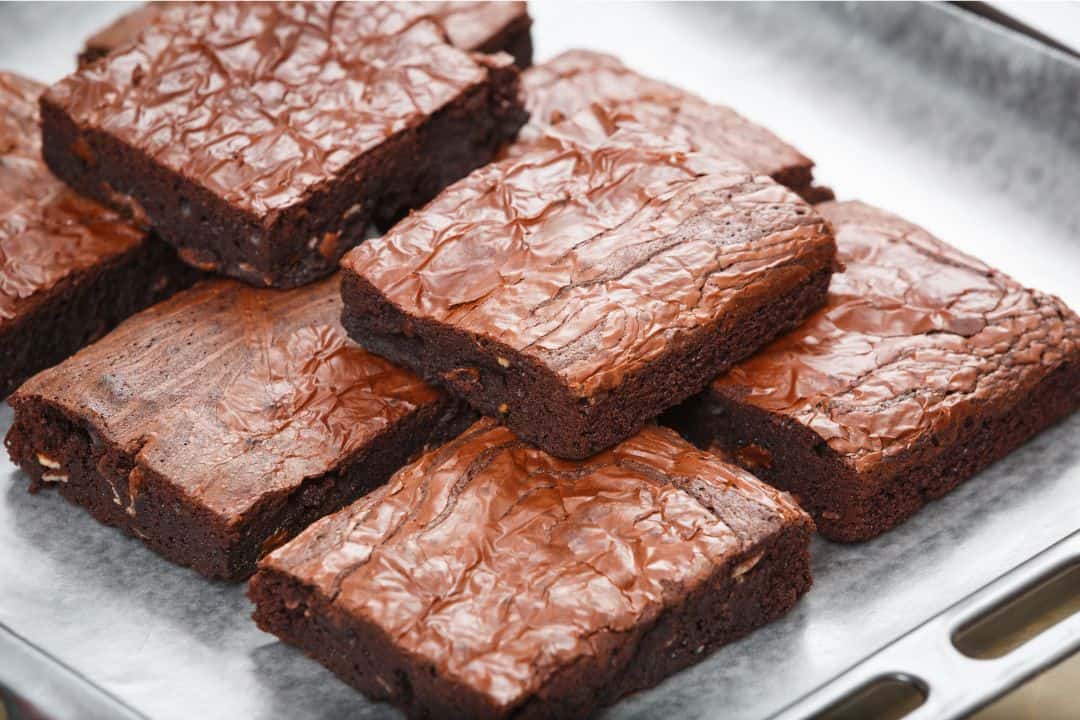How Long to Let Brownies Cool Before Frosting? Tips
One question often arises when baking: how long to let brownies cool before frosting? This seemingly simple query holds significant importance, as the timing can impact your dessert’s texture and flavor.
Whether you’re a seasoned baker or just starting, understanding this crucial step can elevate your brownies from good to exceptional.

Whether you opt for a light-colored metal pan, a thick glass pan, or even muffin tins, each brings its unique touch to the final product. Metal pans, especially dark-colored pans, might require a shorter bake time, whereas a glass pan retains heat, leading to chewier brownies.
Imagine you’ve combined your dry ingredients with wet ingredients, ensuring your cold eggs are incorporated well to boost that chocolate flavor. Pouring your batter into a parchment paper or aluminum foil-lined square pan, ensuring it reaches the sides of the pan, can be pretty satisfying.
However, the real challenge begins once the cake tester comes out with moist crumbs from the center of the brownies. The rule of thumb? Let them cool! And while there’s no hard rule on how much time is perfect, it’s a good idea to allow them to sit in the coolest part of your home.
Placing them on a cooling rack or opting for a quicker cooling method, like immersing the warm pan in cold water, can make a difference.
Proper timing for cooling brownies
Allowing brownies to cool before applying frosting is essential to balance flavors and textures perfectly. Here are some key points to consider when determining how long to let your brownies cool. Cut them.
Recommended cooling time: While there isn’t a one-size-fits-all answer, most experts suggest letting brownies cool for at least 30 minutes before frosting. This allows cool brownies to set and firm up slightly without being too hot.
Remember, every batch of brownies may have slight variations in cooking times and cooling requirements, so feel free to experiment with different durations until you find what works best for you!

Factors Affecting Brownie Cooling Time
Baking Pan Thickness and Size
- The baking pan’s thickness and size can significantly impact a brownie’s cooling duration.
- Thicker pans retain more heat, requiring longer cooling times for brownies.
- Larger pans may also take longer to cool due to increased surface area.
Ingredients Impacting Cooling Time
- Ingredients like chocolate chips or nuts can affect how long brownies need to cool.
- These additions can trap heat, resulting in a slower cooling process.
- The denser the ingredients, the longer it may take for the brownies to cool completely.
Room Temperature and Humidity
Room temperature and humidity are crucial in determining how long you should let your brownies cool. Warmer temperatures and high humidity levels can slow down the cooling process.
On the other hand, cooler room temperatures and lower humidity levels promote faster cooling.
Varying Cooling Times with Different Recipes
Lighter, cake-like brownie recipes may have shorter cooling times.
Quick cooling methods for brownies
You are waiting for them to cool down before frosting can be quite a challenge. Luckily, you can use several quick cooling methods to speed up the process and satisfy your sweet tooth quickly. Here are some tips to help you cool your brownies faster:
Utilizing a wire rack: Placing your hot brownie pan on a wire rack allows for better air circulation around the pan, helping the brownies cool more quickly. This method is especially effective if you’re short on time and need your cooled brownies as soon as possible.

Shallow ice bath: For an even faster cooling process, try placing the entire pan of hot brownies in an external ice bath. The cold temperature from the water will help dissipate heat from the pan and expedite the cool-down time.

Cutting into smaller pieces: To reduce overall cool-down time, consider cutting your cooled brownies into smaller pieces. Doing so exposes more surface area, allowing heat to escape more rapidly.
The Impact of Not Allowing Brownies to Cool
Not allowing brownies to cool properly can have several consequences that may result in a less-than-ideal dessert experience. Here are some potential issues you may encounter if you rush the cooling process:
Uneven heat distribution: When brownies are removed from the oven, they cook for a while as residual heat dissipates throughout the tray. If you frost them too soon, an uneven heat distribution results in inconsistent texture across different parts of the brownie batch.
Frustration when serving undercooked portions: Cutting into undercooked brownies prematurely can leave you with gooey, underdone sections that are difficult to serve neatly. Letting them cool is essential to achieve their desired chewy consistency throughout.
Taking time and allowing brownies to cool before applying frosting is essential for achieving optimal results. By giving them sufficient cooling time, you’ll avoid melted frosting, ensure structural integrity, maintain consistent texture, and enjoy hassle-free cutting and serving experiences.
Remember, patience is vital when creating delicious brownies that satisfy your taste buds and those of many who enjoy your homemade treats!
Best practices for frosting brownies
Instructions
Prepare your desired type of frosting
- Before you start frosting your brownies, ensure you have prepared the frosting you choose. Whether it’s a classic buttercream, a rich ganache, or a tangy cream cheese frosting, organizing it in advance will save you time and ensure smooth application.
Spread an even layer
- To achieve a professional-looking finish, use an offset spatula or a butter knife to spread the frosting evenly over the surface of the cooled brownie. Start from the center and work towards the edges, covering every corner.
Allow ample time for setting
- After you’ve frosted your brownies, give them enough time to set before cutting and serving. This will prevent the frosting from smudging or sliding off when you slice into them.
- Depending on the type of frosting and temperature, this can take anywhere from 30 minutes to a couple of hours.
Consider creative options
- While traditional chocolate ganache or buttercream are always crowd-pleasers, don't hesitate to get creative with your brownie toppings. Experiment with different flavors like mint chocolate chip frosting or peanut butter swirls. You can also opt for a simple yet elegant dusting of powdered sugar for a minimalistic touch.
Notes
Optimal cooling and frosting techniques
Following the proper cooling and frosting techniques is crucial to achieving the perfect brownie experience. Here are some essential tips to consider:
- Allowing the brownies to cool completely before applying any frosting is essential. This ensures that the heat from the freshly baked brownies doesn’t cause the frosting to melt or become runny.
- Make sure the surface of the brownies is not warm to the touch before you start frosting. If it feels warm, give them more time to cool down at room temperature.
- When applying the frosting, aim for an even layer. This enhances the visual appeal and provides a balanced taste throughout each bite.
- After frosting your brownies, exercise patience and let them set before cutting them into individual servings. This allows the frosting to firm up, preventing smudging or messy cuts.
By following these cooling and frosting techniques, you can ensure that your brownies turn out beautifully delicious. Whether making them for yourself or as part of your home baking business, these tips will help you achieve fantastic results.
Can You Let the Brownies Cool Overnight?

Letting brownies cool overnight can be a game-changer. Not only does this method provide several benefits, but it also ensures that your brownies are thoroughly cooled and ready for flawless frosting in the morning.
Refrigeration plays a crucial role in speeding up the cooling process without compromising the deliciousness of your brownies. By placing them in the fridge, you can enjoy firm brownies much faster than if you let them cool at room temperature.
The cold environment helps set the structure of the brownies, resulting in a dense and fudgy consistency.
Cover them adequately to prevent condensation from forming on your brownies while cooling overnight. Using an airtight container or wrapping them tightly with plastic wrap will keep moisture at bay and maintain their delectable texture.
Once you wake up to thoroughly cooled brownies, you’ll find they are prime candidates for frosting perfection. Whether you prefer classic chocolate ganache or cream cheese frosting, these cooled treats provide an ideal canvas for spreading your favorite flavors.
The firmness achieved through overnight cooling ensures that your frosting stays intact without sinking into the brownie’s surface.
So, next time you bake a batch of mouthwatering brownies, consider letting them cool overnight in the refrigerator. With this simple step, you’ll have perfectly cooled and firm brownies waiting for your creative touch of frosting in the morning!
Fast Cooling Steps for Brownies: Different Methods Explained
We discussed the optimal timing for cooling brownies and the factors affecting their cooling time. We provided quick cooling methods for those short on time and emphasized the impact of not allowing brownies to cool adequately.
Moving forward, it is crucial to follow best practices when frosting brownies. Allowing your brownies to cool ultimately ensures that the frosting will adhere properly and maintain its texture without melting or sliding off.
Remember to use a thin layer of frosting evenly across the surface. This will prevent excessive moisture from seeping into the brownie and compromising its texture.
FAQs – How Long to Let Brownies Cool Before Frosting?
Can I speed up the cooling process by placing brownies in the refrigerator?
👉 Yes, refrigerating brownies can help expedite the cooling process. Once they have cooled at room temperature for about 15-20 minutes, you can transfer them to the refrigerator for 30 minutes to an hour.
However, avoid placing hot or warm brownies directly into the fridge as it may cause condensation and affect their texture.
How long should I wait before cutting and serving frosted brownies?
👉 After frosting your brownies, it’s best to set them for another 10-15 minutes before cutting and serving.
This allows time for the frosting to firm up slightly and makes it easier to slice neat squares without smudging or ruining the appearance of your beautiful frosted treats.
Can I freeze frosted brownies?
👉 Yes! If you have leftover frosted brownies or want to prepare them in advance, you can freeze them. Ensure they are thoroughly cooled before wrapping each piece tightly in plastic wrap or storing them in an airtight container.
When ready to enjoy, allow them to thaw at room temperature before serving.
Can I use a fan to cool brownies faster?
👉 Yes, using a fan can help accelerate the cooling process. Place the brownies on a wire rack and position a fan nearby, ensuring it is set on low or medium speed. The airflow will promote faster heat dissipation, resulting in quicker cooling times.
How long should I wait before adding frosting to warm brownies?
👉 It is essential to let your brownies cool completely before adding frosting. Attempting to frost warm brownies can cause the frosting to melt and become runny, resulting in an uneven and messy appearance.
Allow them to cool at room temperature for at least 1-2 hours before applying frosting for best results.

Born and raised in a family of foodies, Georgia’s passion for cuisine was nurtured from a young age as she learned the intricacies of flavor and texture from her grandmother’s kitchen. As an adult, this early fascination blossomed into a full-fledged love affair with the culinary world.









